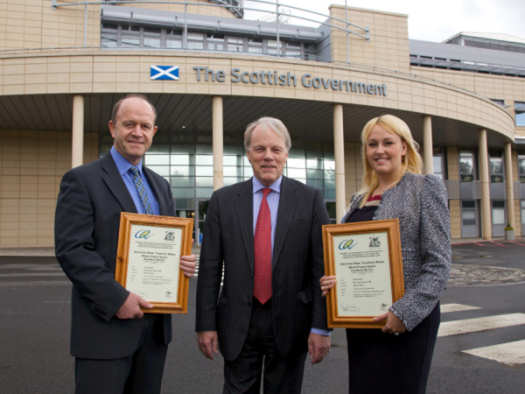Glencorse Water Treatment WorksWinner of a CEEQUAL Outstanding Achievement Award 2013 for Community Relations |
|
Whole project award
Project Team
Client: Scottish
Water
Design: BDP, Black
& Veatch and ERM
Construction: Black &
Veatch
The Project
Scottish Water's new Glencorse Water Treatment Works (WTW) is delivering
21st century drinking water to around 450,000 people across Scotlands
modern capital city. The works replaces two ageing facilities at Fairmilehead
and Alnwickhill, which despite having served the city well for more
than a century, now need replacing.
Combining engineering feasibility reports with the results of the largest ever community consultation in Scottish Water's history the site at Glencorse in Midlothian was chosen for the project to take place.
Capable of supplying Edinburgh with up to 175-million litres of clear, fresh drinking water everyday, the Glencorse project has sustainability at its core. A third of the works energy needs will be provided by an on-site hydro turbine. This is driven by the raw water which arrives from reservoirs in the Borders using gravity alone.
This raw water supply is treated beneath the largest 'grass' roof in Scotland, before being stored in a 90 million litre storage tank - one of the largest in Europe - and is delivered to customers across the city, again using gravity alone. Rain water harvested from the 'grass' roof is passed to bio-diverse wetlands that provide a rich habitat for indigenous plants, animals and insects.
Influence of CEEQUAL
Considering CEEQUAL, Scottish Water and Black & Veatch introduced
a world first, a mobile pipeline production unit. The plant was located
next to the trunk main route allowing engineers to roll the pipes out
of the factory and straight into the ground. This helped to save more
than a million lorry miles and the associated carbon dioxide emissions.
Tunnelling underneath the Edinburgh City Bypass allowed work on the pipeline to progress without disturbing the thousands of commuters who use this vital artery every day.
Waste Management
Spoil from initial excavation work was stored on site, to be used in
landscaping the facility, blending it into the Pentland Hills. This
helped to reduce construction traffic by 75%, making local roads safer.
The use of recycled materials on-site also exceeded 25%.
Effects on Neighbours
Those residing round the WTW's perimeter have been consulted throughout,
providing input into the height and scale of final landscaping. Homeowners
were even consulted on the location of individual trees providing final
landscaping.
The Historic Environment
Following early archaeological investigations a Roman Marching Camp
was discovered. Again neighbours were consulted to decide the relocation
of the treatment building, preserving this historic site.
This information was presented along with Cromwellian finds and evidence of a WWII Army Camp that was unearthed during excavations - resulting in 177 visitors to an Archaeological Open Day for Residents.
Award presentation



